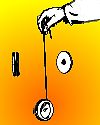
In 1866, the first U.S. patent for a yoyo was issued to James L. Haven and Charles Hittrick of Cincinnati, Ohio. Although termed a “Whirligig” or a “Bandalore” in the patent title, it had the familiar construction of a yoyo with two disks “coupled together at their centers by means of a clutch.” It was also the first time rim-weighting to maintain momentum was mentioned in a patent. “It will be observed that the marginal swell ... exercises the function of a flywheel.” This patent is important since it shows the first use of patents to protect design improvements in the manufacture of a yoyo. Messrs. Haven and Hettrick were in the business of mass-producing yoyos over a half century before the better known Flores brand.
What do a yo-yo, a silk panel hanging from a trumpet, and a quiz have in common? You may be surprized how the yo-yo toy you played with when young has a long and fascinating historical background. Read the Today in Science History article on the Etymology and History of the Yo-Yo.
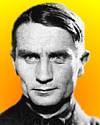
Trofim Lysenko died 20 Nov 1976, having been perhaps the most evil, destructive power against true scientific biological knowledge in modern history. He retarded an entire generation of Soviet biology, by destroying careers, and (through the dictator's support) causing the imprisonment or death of many eminent Russian biologists. Today's book pick is: , by . This book is a translation of the Russian written by Zhores Medvedev and smuggled out of Russia on microfilm. It reveals the first detailed, inside account of Soviet genetics in the period 1937-1964, which was perhaps the most bizarre chapter in the history of modern science. In a society devoted to the betterment of the lot of peasants and workers, an illiterate and fanatical charlatan, T. D. Lysenko, was allowed absolute control over both research in biology and practical agriculture. Lysenko's belief that environment was everything and heredity was next to nothing not only stifled the development of science, but also had a far-reaching and destructive influence on the national economy of the Soviet Union.
It is available from Amazon, typically about (As of earlier time of writing - subject to change.)
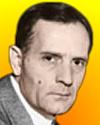 | The history of astronomy is a history of receding horizons. |
 | Increasing knowledge lessens the sphere of the supernatural. |
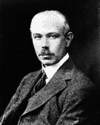 | [S]uppose you make a hole in an ordinary evacuated electric light bulb and allow the air molecules to pass in at the rate of 1,000,000 a second, the bulb will become full of air in approximately 100,000,000 years. |
| Before you look at today's web page, see if you can answer some of these questions about the events that happened on this day. Some of the names are very familiar. Others will likely stump you. Tickle your curiosity with these questions, then check your answers on today's web page. | |
| Births | |
 | Edwin Hubble, an American astronomer, born 20 Nov 1889, is considered the founder of extragalactic astronomy and provided the first evidence of the expansion of the universe. He measured distances to galaxies and their redshifts, and in 1929 he published the velocity-distance relation which is the basis of modern cosmology. The now-standard classification of galaxies by shape came from him. What are the three main standard shapes he used to classify galaxies? |
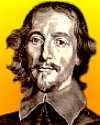 | Otto von Guericke, born 20 Nov 1602, was a German physicist, engineer, and natural philosopher who studied the role of air in combustion and respiration, but is better-known for his other investigations using an invention that was the first of its kind. What was this invention and what did he study with it? |
| Deaths | |
 | Francis William Aston (1877-1945) was a British physicist who won the Nobel Prize for Chemistry in 1922 for his development of the mass spectrograph What does the mass spectrograph measure? |
 | Trofim Lysenko (1898-1976) was a Soviet biologist and agronomist who not only believed the Mendelian theory of heredity to be wrong, but with the Soviet dictator's support for two decades actively obstructed the course of Soviet biology. He caused the imprisonment and death of many of the country's eminent biologists. Who was the dictator who supported Lysenko? |
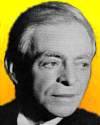 | Casimir Funk (1884-1967) was a Polish-American biochemist who pusued the idea that diseases such as beriberi, scurvy, rickets and pellagra were caused by lack of vital substances in the diet. What name did he give these substances? |
| Events | |
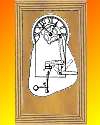 | On 20 Nov of a certain year, Willard LeGrand Bundy was issued the first U.S. patent for a time recording clock. A workman inserted a key which actuated his number which was printed with the time on a paper tape. In what decade was this first time recording clock patented? |
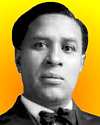 | On 20 Nov 1923, African-American Garrett Morgan (1877-1963) patented an invention he developed after he had seen an automobile crash into a horse-drawn carriage. What was his invention? |
Fast answers for the previous newsletter for November 19: periodic polar reversals of the Earth's magnetic field • Peru, Incas • Suez Canal across the Isthmus of Suez in Egypt • measuring tornadoes on the basis of their damage • decade containing the year 1861.
 If you enjoy this newsletter, the website, or wish to offer encouragement or ideas, please send feedback by using your mail reader Reply button.
If you enjoy this newsletter, the website, or wish to offer encouragement or ideas, please send feedback by using your mail reader Reply button. Your click on a Facebook, StumbleUpon, or other social button on the site webpages is also a welcome sign of appreciation. Thank you for using them.
© This newsletter is copyright 2020 by todayinsci.com. Please respect the Webmaster's wishes and do not put copies online of the Newsletter — or any Today in Science History webpage. (If you already have done so, please remove them. Thank you.) Offline use in education is encouraged such as a printout on a bulletin board, or projected for classroom viewing. Online, descriptive links to our pages are welcomed, as these will provide a reader with the most recent revisions, additions and/or corrections of a webpage. For any other copyright questions, please contact the Webmaster by using your mail reader Reply button.
--
If you do not want to receive any more newsletters, Unsubscribe
To update your preferences and to unsubscribe visit this link
Executive Real Estate Business Class
-
"It was like a man with wings. It wasn't like anything you'd see on TV or in a monster movie." ...
About the publisher
Search This Blog
Blog Archive
-
▼
2020
(1542)
-
▼
November
(164)
- Last day to save! Take advantage of Black Friday d...
- On This Day for November 30 - Independence of Barb...
- Newsletter for Monday 30 November.
- November 30: Cnut the Great, the 1st State to Abol...
- FAMILY: Happiness in a stressful season
- Medieval monarchs | WW1 quiz | Marlborough pie recipe
- On This Day for November 29 - United Nations resol...
- Newsletter for Sunday 29 November.
- November 29: Edison's Phonograph, Schrödinger's Ca...
- The Compass: Italy
- See the past through a different lens with Nat Geo...
- On This Day for November 28 - Opening of Tehrān Co...
- Newsletter for Saturday 28 November.
- November 28: Exploration, Invention and a Day of F...
- PHOTOGRAPHY: How adversity inspired discovery for ...
- The gift of curiosity lasts a lifetime. Give Nat G...
- Very Weird — And Very Real — Facts About The Victo...
- Black Friday Deals: Save 50% on a Britannica Membe...
- Black Friday Savings at the HISTORY Store
- On This Day for November 27 - Nobel Prizes establi...
- Newsletter for Friday 27 November.
- November 27: The Model Parliament, the 1st Native ...
- ANIMALS: The pets I’m thankful for
- A Very Special Thanksgiving Edition Of Our Newsletter
- On This Day for November 26 - Premiere of Casablan...
- Newsletter for Thursday 26 November.
- YOUR WEEKLY ESCAPE: They live in a legendary under...
- November 26: 1st National Thanksgiving, Alice in W...
- SCIENCE: The prehistoric truth about turkeys
- UPDATED: Every Membership Now 50% Off!
- Every Membership Now 50% Off!
- Demystified: Is the Ozone Layer Finally Healing It...
- On This Day for November 25 - Japanese military ba...
- Newsletter for Wednesday 25 November.
- November 25: Dynamite and The Mousetrap
- TRAVEL: Keeping your family safe over the holidays
- Meet The Real-Life "Dexter" — Serial Killer Of Mur...
- On This Day for November 24 - Dutch discovery of T...
- Newsletter for Tuesday 24 November.
- November 24: 1st Transit of Venus Observed, Van Di...
- HISTORY: The faces of COVID-19’s toll
- New This Week on History News Network
- On This Day for November 23 - Ley Juárez passed, I...
- Newsletter for Monday 23 November.
- November 23: On This Day in History
- FAMILY: Keeping the holidays familiar for your kids
- The many faces of Anne Boleyn | Take our Tudors qu...
- On This Day for November 22 - U.S. President John ...
- Newsletter for Sunday 22 November.
- November 22: Vasco da Gama Rounds the Cape and JFK...
- The Compass: Hawaii
- On This Day for November 21 - Signing of Mayflower...
- Newsletter for Saturday 21 November.
- November 21: The Mayflower Compact, a Jewish state...
- CORONAVIRUS UPDATE: 200,000 new cases in a single day
- PHOTOGRAPHY: Switching tactics to chronicle the wo...
- How The Kennedy Curse Has Tormented America's Firs...
- On This Day for November 20 - Mexican Revolution l...
- The Roundup Top Ten for November 20, 2020
- Newsletter for Friday 20 November.
- November 20: Uyghurs Conquer China, the Napoleonic...
- ANIMALS: The deadly thing about snakes
- Give your kids a love of learning with Nat Geo Kid...
- #1 Gift for Families this Holiday - On Sale Now!
- On This Day for November 19 - Anwar Sadat's visit ...
- Newsletter for Thursday 19 November.
- November 19: "Four Score and Seven Years Ago..."
- YOUR WEEKLY ESCAPE: Not all of the dinosaurs died
- SCIENCE: Can we make North America’s greatest reso...
- The Latest News from History News Network
- On This Day for November 18 - Jonestown massacre, ...
- Newsletter for Wednesday 18 November.
- November 18: St. Peter's Basilica is Consecrated a...
- TRAVEL: Best of the World 2021
- Black Friday Early Access! 50% off Holiday Bundles...
- Photographer Captures the Impacts of Climate Chang...
- On This Day for November 17 - Arnold Schwarzenegge...
- Newsletter for Tuesday 17 November.
- November 17: On This Day in History
- HISTORY: Thanksgiving in tough times
- New This Week on History News Network
- On This Day for November 16 - Election of Bhutto a...
- Newsletter for Monday 16 November.
- November 16: Francisco Pizarro Ambushes Atahualpa,...
- FAMILY: Keeping kids kind during this stressful time
- The Crown S4 | Henry VIII's seventh wife | Vikings...
- On This Day for November 15 - Palestinian statehoo...
- Newsletter for Sunday 15 November.
- November 15: The Scramble for Africa and the Vietn...
- The Compass: Peru
- On This Day for November 14 - Eritrea made a provi...
- Newsletter for Saturday 14 November.
- CORONAVIRUS UPDATE: The U.S. enters uncharted terr...
- November 14: Kirch's Comet, Einstein's Theory of L...
- PHOTOGRAPHY: In the land of Arctic dreams
- The Unhinged Soldier Who Avenged Lincoln's Assassi...
- The Roundup Top Ten for November 13, 2020
- On This Day for November 13 - Terrorist attacks in...
- Newsletter for Friday 13 November.
- ANIMALS: Images to surprise and delight during thi...
-
▼
November
(164)
-
Blogroll
-
About
HistoryFact










0 comments:
Post a Comment